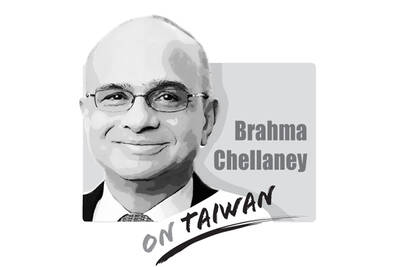It is clear that whoever hopes to win the presidential election next year will have to propose a sound strategy on how to deal with China: not just politically, but also economically.
The process of cross-strait economic liberalization launched in the 1980s and sustained even under the pro-independence Democratic Progressive Party from 2000 until 2008, accelerated dramatically after President Ma Ying-jeou (馬英九) of the Chinese Nationalist Party (KMT) stepped into office on May 20, 2008. With the signing of the Economic Cooperation Framework Agreement (ECFA) in June last year and various other economic pacts in recent years, the dependence of Taiwan’s economy on China has grown by leaps and bounds.
Putting the political implications of those agreements aside, we will leave it to the history books to judge whether the decision to open the gates to Chinese money was economically sound for Taiwan. A growing number of economists are claiming that China’s economic miracle is heading full speed for a brick wall. Although such predictions have been made for more than a decade, there is evidence that this time the alarmists could be right.
Should such pessimistic forecasts come to pass, the more dependent Taiwan is on China for its economic well-being, the more severe the repercussions of a downturn across the Taiwan Strait will be.
Earlier this month, renowned economist Nouriel Roubini was warning of potentially destabilizing contradictions between China’s short and medium-term economic performance. In his view, China was able to weather the global economic crisis and sustain double-digit economic growth by artificially propping up its economy with major infrastructure projects.
However, this stopgap measure cannot go on indefinitely and already the construction spree is catching up with China as evidenced by low usage of its high-speed rail systems, highways leading to nowhere and steel-and-glass ghost towns. Furthermore, a recent scandal about the safety of China’s new ultramodern high-speed rail system has highlighted the prohibitive cost of construction and operation. The rail system, which was part of Beijing’s stimulus plan for 2008, is already losing money and depends for its survival on bank loans. The Chinese Ministry of Finance last week confirmed that its debt currently stands at US$276 billion, which was almost entirely borrowed from Chinese banks.
A great share of the massive infrastructure projects that have sustained the illusion of a booming Chinese economy has been buttressed by bank loans and many of those are non-performing and will very likely never be reimbursed. Add rampant corruption, as was ostensibly the case with the underused high-speed rail, to this mix and there are the makings of an economic time bomb — the consequences of which for the Chinese economy (and the region) one can only guess at.
For Taiwan, these signs should awaken officials to the need to implement prophylactic measures in the event the Chinese economy implodes. The key to this is threefold: ensuring Chinese money in Taiwan comes from economically sound institutions; redoubling efforts to attract foreign investment from sources other than China; and diversifying export destinations (Taiwan’s exports to China plus Hong Kong last year accounted for about 42 percent of total exports. Inflation, or a major economic downturn in China, would have a serious negative impact on Taiwan’s exports).
While there is no way to avoid significant trade with the giant next door, the candidates in next year’s presidential election should clearly explain to the public how they intend to hedge against a possible rainy day in China. It’s not a question of whether Taiwan should deal with China or not, but how.

China badly misread Japan. It sought to intimidate Tokyo into silence on Taiwan. Instead, it has achieved the opposite by hardening Japanese resolve. By trying to bludgeon a major power like Japan into accepting its “red lines” — above all on Taiwan — China laid bare the raw coercive logic of compellence now driving its foreign policy toward Asian states. From the Taiwan Strait and the East and South China Seas to the Himalayan frontier, Beijing has increasingly relied on economic warfare, diplomatic intimidation and military pressure to bend neighbors to its will. Confident in its growing power, China appeared to believe
After more than three weeks since the Honduran elections took place, its National Electoral Council finally certified the new president of Honduras. During the campaign, the two leading contenders, Nasry Asfura and Salvador Nasralla, who according to the council were separated by 27,026 votes in the final tally, promised to restore diplomatic ties with Taiwan if elected. Nasralla refused to accept the result and said that he would challenge all the irregularities in court. However, with formal recognition from the US and rapid acknowledgment from key regional governments, including Argentina and Panama, a reversal of the results appears institutionally and politically
In 2009, Taiwan Semiconductor Manufacturing Co (TSMC) made a welcome move to offer in-house contracts to all outsourced employees. It was a step forward for labor relations and the enterprise facing long-standing issues around outsourcing. TSMC founder Morris Chang (張忠謀) once said: “Anything that goes against basic values and principles must be reformed regardless of the cost — on this, there can be no compromise.” The quote is a testament to a core belief of the company’s culture: Injustices must be faced head-on and set right. If TSMC can be clear on its convictions, then should the Ministry of Education
The Chinese People’s Liberation Army (PLA) provided several reasons for military drills it conducted in five zones around Taiwan on Monday and yesterday. The first was as a warning to “Taiwanese independence forces” to cease and desist. This is a consistent line from the Chinese authorities. The second was that the drills were aimed at “deterrence” of outside military intervention. Monday’s announcement of the drills was the first time that Beijing has publicly used the second reason for conducting such drills. The Chinese Communist Party (CCP) leadership is clearly rattled by “external forces” apparently consolidating around an intention to intervene. The targets of